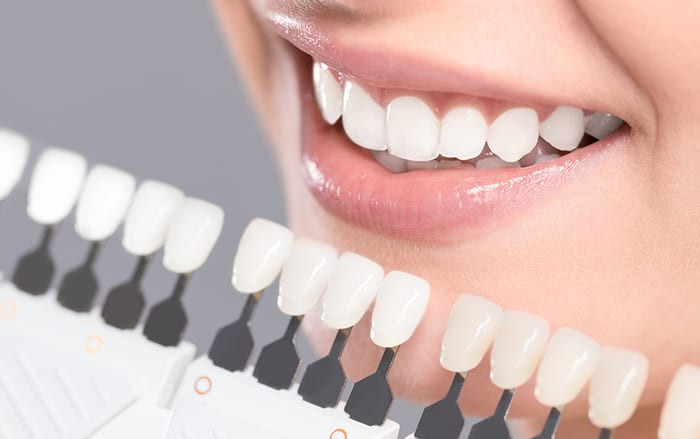
A bright white smile with teeth whitening

HIGHLIGHTS:
- Brushing teeth twice a day, daily flossing, avoiding food and drinks that contain coloring, not smoking, attending dental check-ups and having your teeth scaled twice a year are things that everyone can do to help prevent tooth discoloration.
- White Speed Technology: Advanced LED is a safe one-time method for teeth whitening that can leave teeth 3 – 8 levels whiter.
- Should you suffer from tooth discoloration, consulting a dentist who will analyze your situation and diagnose the causes of your problem can be a safe and effective way to identify a solution to the problem.
It is undeniable that beautiful teeth can increase a person’s confidence when smiling.
However, it is also true that straight, white teeth play a crucial role with regard to a person’s facial feature balance, making their smile enticing and improving how they come across during interactions with others.
Causes of teeth discoloration
- Regularly consuming beverages that contain coloring, such as tea and coffee, as well as sucking sweets or some types of medicated lozenges.
- Smoking and not brushing teeth properly, resulting in food residue, bacteria and plaque accumulation on the teeth, may eventually cause yellow, brown or black coloration, although this is treatable with scaling.
- Tooth decay can cause deep yellow or brown coloration, especially in the most visible teeth located at the front of the mouth. Tooth decay can be treated with fillings.
- Dead teeth can cause discoloration and dullness that differs from living teeth. A dead tooth refers to a tooth that is lacking in nerve endings and circulation, often caused by severe tooth decay that is left untreated for an extended time allowing the decay to penetrate the nerves located in the pulp of the tooth. Nevertheless, dead teeth may also be caused by an injury or impact causing a tear in the blood vessels serving the tooth which, if not treated with removal, can lead to darkening of the tooth. Treatment consists of root canal treatment that enables the dentist to use a whitening solution on the pulp in order to leave the tooth looking whiter. However, in cases of severe darkening, tooth crowning may be necessary.
- Congenital dental abnormalities that may result from disease or over exposure to some forms of medication such as tetracycline can impact tooth color, particularly during teething between the ages of 3–9 months, and when adult teeth are coming in from the ages of 3 –12 years. The effects of such medication can be general yellowing of nearly all the teeth, or clearly visible grayish-black lines on the teeth.
- Overexposure to fluoride, resulting in brown and white spots on the teeth—more commonly known as dental flurosis. Scaling is an ineffective treatment, meaning that veneers or crowns must be utilized.
- The enamel on our teeth thins with age, leading to yellow or brown coloration as the tooth’s dentin becomes more clearly visible.
Teeth whitening techniques
Advances in medical technology mean that teeth whitening is now a simple and safe process and can be carried out in the following ways:
- In-office bleaching.
- At-home bleaching.
- Use of over-the-counter products.
Potential side effects linked to teeth whitening
Side effects that may result from the teeth whitening process include:
- Hypersensitive teeth can be a result of any and all forms of teeth whitening, although such symptoms tend to disappear within 2–5 days. Overly hot and cold foods should be avoided during the initial period subsequent to teeth whitening. Severe sensitivity may require teeth whitening to be halted altogether for 2–3 days alongside the use of special sensitivity-reducing toothpaste products, which contain potassium nitrate or fluoride as their active ingredients.
- Stinging gums or oral tissue usually result from the use of over-the-counter products due to incorrect bleaching tray placement, resulting in contact with oral tissue. The specially produced trays used by dentists fit tightly to the teeth and are therefore less likely to produce such a side effect.
Post-whitening care
For long-lasting results, brush your teeth twice a day, floss daily, avoid food and drink that contains coloring, do not smoke, attend regular dentist appointments and have your teeth scaled twice a year.
Teeth whitening is now both simple and safe, meaning it can be carried out at home through consultation with a dentist, or even by utilizing over-the-counter products. However, regularly attending dentist health screening appointments that can identify the causes of tooth discoloration is the best and most effective way to keep teeth looking white, while also eliminating potential treatment side effects and reducing the likelihood of dental health problems occurring in the future.
One of the newest forms of treatment currently available is White Speed Technology: Advanced LED, an extremely safe method that offers 3–8 levels of teeth whitening through a one-time process that typically lasts around 30–60 minutes.
*Required
Related
articles
